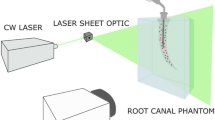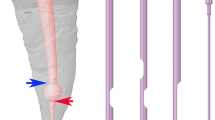Abstract
During a root canal treatment the root canal is irrigated with an antimicrobial fluid, commonly performed with a needle and a syringe. Irrigation of a root canal with two different types of needles can be modeled as an impinging axisymmetric or non-axisymmetric jet. These jets are investigated experimentally with high-speed Particle Imaging Velocimetry, inside and outside the confinement (concave surface) of a root canal, and compared to theoretical predictions for these jets. The efficacy of irrigation fluid refreshment with respect to the typical reaction time of the antimicrobial fluid with a biofilm is characterized with a non-dimensional Damköhler number. The pressure that these jets induce on a wall or at the apex of the root canal is also measured. The axisymmetric jet is found to be stable and its velocity agrees with the theoretical prediction for this type of jet, however, a confinement causes instabilities to the jet. The confinement of the root canal has a pronounced influence on the flow, for both the axisymmetric and non-axisymmetric jet, by reducing the velocities by one order of magnitude and increasing the pressure at the apex. The non-axisymmetric jet inside the confinement shows a cascade of eddies with decreasing velocities, which at the apex does not provide adequate irrigation fluid refreshment.













Similar content being viewed by others
Abbreviations
- u, v :
-
velocity in r and y direction
- ρ:
-
fluid density
- ν:
-
fluid dynamic viscosity
- R, D :
-
jet radius, diameter
- Q :
-
flow rate
- \(Re = \frac{v D}{\nu}\) :
-
Reynolds number
- d :
-
distance between the needle tip and the apex or wall
- d stag :
-
distance from the plate or apex where stagnation flow holds
- θ:
-
angle under which flow exits the needle
- α:
-
(root canal) cone angle
- μ:
-
eigenvalue of the stream function inside a cavity
References
Adcock JM, Sidow SJ, Looney SW, Liu Y, McNally K, Lindsey K, Tay FR (2011) Histologic evaluation of canal and isthmus debridement efficacies of two different irrigant delivery techniques in a closed system. J Endod 37(4):544–548
Amato M, Vanoni-Heineken I, Hecker H, Weiger R (2011) Curved versus straight root canals: the benefit of activated irrigation techniques on dentin debris removal. Oral Surg Oral Med Oral Pathol Oral Radiol Endod 111(4):529–534
Baker R (1947) Studies on the reaction between sodium hypochlorite and proteins. Biochemistry 41:337–342
Boutsioukis C, Lambrianidis T, Kastrinakis E, Bekiaroglou P (2007) Measurement of pressure and flow rates during irrigation of a root canal ex vivo with three endodontic needles. Int Endod J 40:504–513
Boutsioukis C, Lambrianidis T, Kastrinakis E (2009) Irrigant flow within a prepared root canal using various flow rates: a computational fluid dynamics study. Int Endod J 42:144–155
Boutsioukis C, Verhaagen B, Versluis M, Kastrinakis E, Wesselink PR, Vander Sluis LWM (2010) Evaluation of irrigant flow in the root canal using different needle types by an unsteady computational fluid dynamics model. J Endod 36(5):875–879
Boutsioukis C, Gogos C, Verhaagen B, Versluis M, Kastrinakis E, Vander Sluis LWM (2010) The effect of apical preparation size on irrigant flow in root canals evaluated using an unsteady computational fluid dynamics model. Int Endod J 43:874–881
Boutsioukis C, Gogos C, Verhaagen B, Versluis M, Kastrinakis E, Vander Sluis LWM (2010) The effect of root canal taper on the irrigant flow: evaluation using an unsteady computational fluid dynamics model. Int Endod J 43:909–916
Boutsioukis C, Verhaagen B, Versluis M, Kastrinakis E, Vander Sluis LWM (2010) Irrigant flow in the root canal: experimental validation of an unsteady computational fluid dynamics model using high-speed imaging. Int Endod J 43:393–403
Cohen S, Hargreaves KM (2006) Pathways of the pulp, 9th edn. Mosby Elsevier, Amsterdam
Cornaro C, Fleischer AS, Goldstein RJ (1999) Flow visualization of a round jet impinging on cylindrical surfaces. Exp Thermal Fluid Sci 20:66–78
Deshpande MD, Vaishnav RN (1982) Submerged laminar jet impingement on a plane. J Fluid Mech 114:213–236
Gao Y, Haapasalo M, Shen Y, Wu H, Li B, Ruse ND, Zhou X (2009) Development and validation of a three-dimensional computational fluid dynamics model of root canal irrigation. J Endod 35(9):1282–1287
Gau C, Shen CH, Wang ZB (2009) Peculiar phenomenon of micro-free-jet flow. Phys Fluids 21(092001):1–13
Glauert MB (1956) The wall jet. J Fluid Mech 1(6):625–643
Haapasalo M, Endal U, Zandi H, Coil JM (2005) Eradication of endodontic infection by instrumentation and irrigation solutions. Endodontic Topics 10:77–102
Hülsmann M, Rödig T, Nordmeyer S (2009) Complications during root canal irrigation. Endod Topics 16:27–63
Kahn FH, Rosenberg PA, Gliksberg J (1995) An in vitro evaluation of the irrigating characteristics of ultrasonic and subsonic handpieces and irrigating needles and probes. J Endod 21(5):277–280
Kent EF (1999) Flow visualization experiments in a v-shaped channel bounded by a cylindrical surface. J Phys Soc Jpn 68(6):1887–1890
Meinhart C, Wereley S, Gray M (2000) Volume illumination for two-dimensional particle image velocimetry. Meas Sci Technol 11:809–814
Moffatt HK (1964) Viscous and resistive eddies near a sharp corner. J Fluid Mech 18:1–18
Moorer WR, Wesselink PR (1982) Factors promoting the tissue dissolving capability of sodium hypochlorite. Int Endod J 15:187–196
Moser JB, Heuer MA (1982) Forces and efficacy in endodontic irrigation systems. Oral Surg Oral Med Oral Pathol Oral Radiol Endod 53(4):425–428
Nair P (2004) Pathegenesis of apical periodontitis and the causes of endodontic failures. Crit Rev Oral Biol Med 15(6):348–381
Paqué F, Boessler C, Zehnder M (2011) Accumulated hard tissue debris levels in mesial roots of mandibular molars after sequential irrigation steps. Int Endod J 44(2):148–153
Phares DJ, Smedley GT, Flagan RC (2000a) The inviscid impingement of a jet with arbitrary velocity profile. Phys Fluids 12(8):2046–2055
Phares DJ, Smedley GT, Flagan RC (2000b) The wall shear stress produced by the normal impingement of a jet on a flat surface. J Fluid Mech 418:351–375
Raffel M, Willert CE, Wereley ST, Kompenhans J (2007) Particle imaging velocimetry—a practical guide, 2nd edn. Springer, Berlin
Rubel A (1980) Computations of jet impingement on a flat surface. AIAA J 182(2):168–175
Schlichting H, Gersten K (2000) Boundary-layer theory, 8th edn. Springer, Berlin
Sena N, Gomes BP, Vianna ME, Berber VB, Zaia AA, Ferraz CCR, Souza-Filho FJ (2006) In vitro antimicrobial activity of sodium hypochlorite and chlorhexidine against selected single-species biofilms. Int Endod J 39:878–885
Shankar PN, Deshpande MD (2000) Fluid mechanics in the driven cavity. Annu Rev Fluid Mech 32:93–136
Taneda S (1979) Visualization of separating Stokes flows. J Phys Soc Jpn 46(6):1935–1942
Taylor G (1966) Oblique impact on a plane surface. Philos Trans Royal Soc Lond Series A Math Phys Sci 260(1110):96–100
Won Y, Wang EN, Goodson KE, Wenny TW (2011) 3-D visualization of flow in microscale jet impingement systems. Int J Therm Sci 50:325–331
Acknowledgments
The authors would like to thank Gerrit de Bruin and Leen van Wijngaarden for their help in calculating the theoretical free jet flow profile. BV is funded through project number 07498 of the Dutch Technology Foundation STW; CB has a Marie Curie Intra-European Fellowship for Career Development.
Author information
Authors and Affiliations
Corresponding author
Rights and permissions
About this article
Cite this article
Verhaagen, B., Boutsioukis, C., Heijnen, G.L. et al. Role of the confinement of a root canal on jet impingement during endodontic irrigation. Exp Fluids 53, 1841–1853 (2012). https://doi.org/10.1007/s00348-012-1395-0
Received:
Revised:
Accepted:
Published:
Issue Date:
DOI: https://doi.org/10.1007/s00348-012-1395-0




